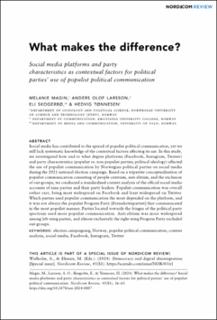| dc.contributor.author | Magin, Melanie | |
| dc.contributor.author | Larsson, Anders Olof | |
| dc.contributor.author | Skogerbø, Eli | |
| dc.contributor.author | Tønnesen, Hedvig | |
| dc.date.accessioned | 2024-03-14T10:22:36Z | |
| dc.date.available | 2024-03-14T10:22:36Z | |
| dc.date.created | 2023-10-25T20:14:14Z | |
| dc.date.issued | 2024 | |
| dc.identifier.citation | Nordicom Review. 2024, 45 (S1), 36-65. | en_US |
| dc.identifier.issn | 1403-1108 | |
| dc.identifier.uri | https://hdl.handle.net/11250/3122376 | |
| dc.description.abstract | Social media has contributed to the spread of populist political communication, but we still lack a systematic knowledge of the contextual factors affecting its use. In this study, we investigated how and to what degree platforms (Facebook, Instagram, Twitter) and party characteristics (populist vs. non-populist parties; political ideology) affected the use of populist communication by Norwegian parties on social media during the 2021 national election campaign. Based on a tripartite conceptualization of populist communication consisting of people-centrism, anti-elitism, and the exclusion of outgroups, we conducted a standardized content analysis of the official social media accounts of nine parties and their party leaders. Populist communication was overall rather rare. It was the most widespread on Facebook and the least widespread on Twitter. Which parties used populist communication the most depended on the platform, and it was not always the populist Progress Party who communicated most populist. Parties located towards the fringes of the party spectrum used more populist communication. Anti-elitism was more widespread among left parties, and almost only the right-wing Progress Party excluded outgroups. | en_US |
| dc.description.abstract | What makes the difference? Social Media Platforms and Party Characteristics as Contextual Factors for Parties’ Use of Populist Political Communication | en_US |
| dc.language.iso | eng | en_US |
| dc.publisher | Sciendo | en_US |
| dc.rights | Attribution-NonCommercial-NoDerivatives 4.0 Internasjonal | * |
| dc.rights.uri | http://creativecommons.org/licenses/by-nc-nd/4.0/deed.no | * |
| dc.title | What makes the difference? Social Media Platforms and Party Characteristics as Contextual Factors for Parties’ Use of Populist Political Communication | en_US |
| dc.title.alternative | What makes the difference? Social Media Platforms and Party Characteristics as Contextual Factors for Parties’ Use of Populist Political Communication | en_US |
| dc.type | Journal article | en_US |
| dc.type | Peer reviewed | en_US |
| dc.description.version | publishedVersion | en_US |
| dc.source.pagenumber | 36-65 | en_US |
| dc.source.volume | 45 | en_US |
| dc.source.journal | Nordicom Review | en_US |
| dc.source.issue | S1 | en_US |
| dc.identifier.doi | https://doi.org/10.2478/nor-2024-0007 | |
| dc.identifier.cristin | 2188574 | |
| cristin.ispublished | true | |
| cristin.fulltext | original | |
| cristin.qualitycode | 1 | |

